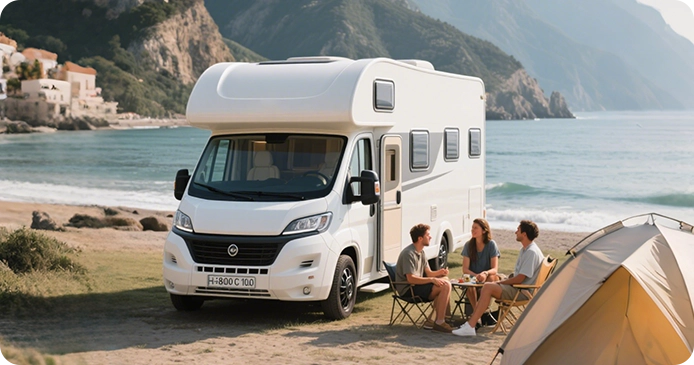Golf carts are a practical and enjoyable way to get around the course, your neighbourhood, or a campground. If you’re thinking about switching to lithium power for your 48V golf cart, you’ve probably wondered, “How many lithium batteries for a golf cart do I actually need?” That question is essential to keep your cart—whether it’s an EZGO, Yamaha, or Club Car—running smoothly and consistently.
In general, lithium batteries provide clear advantages over traditional lead-acid options, but selecting the right quantity and configuration means understanding how your specific cart is used. In this guide, we’ll walk through the fundamentals of powering a 48V golf cart with lithium batteries, including typical setups, what to consider when choosing batteries, installation pointers, and more so you can make a well-informed choice.
What Powers a 48V Golf Cart? Understanding Battery Basics
A 48V golf cart is an electric vehicle driven by a 48-volt battery system, commonly used for golf courses, planned communities, and leisure activities like camping. Major brands such as EZGO, Yamaha, and Club Car rely on this voltage because it balances torque, speed, and efficiency. Traditionally, 48V is achieved with four 12V batteries or two 24V batteries wired in series.
However, it’s generally not recommended to rely on multiple separate batteries commonly used in golf carts connected in series over the long term, because the individual voltages can drift out of balance. This imbalance may increase the risk of issues such as sudden power loss or reduced performance.
A typical 18-hole round can draw roughly 3–6 kWh, depending on elevation changes, driving style, and passenger weight, so selecting suitable lithium golf cart batteries is important to cover this energy use. Unlike petrol-powered carts, electric models depend entirely on their battery pack, which is why upgrading to lithium has become a popular way to improve reliability and lifespan.
Why Choose Lithium Batteries for Your 48V Golf Cart?
Moving to a dedicated 48V lithium battery setup offers clear advantages compared with traditional lead-acid batteries and is an attractive option for many golf cart owners. Here’s why lithium golf cart batteries, including those from Vatrer, are worth considering:
Higher Energy in a Smaller Package: Lithium batteries provide much higher energy density (about 150–250 Wh/kg versus 30–50 Wh/kg for lead-acid), supporting a driving range of roughly 20–80 miles on a full charge.
Reduced Overall Weight: Because they can be up to about 70% lighter, lithium packs improve handling, especially on uneven or hilly courses, and put less strain on suspension and other components.
Extended Service Life: Many lithium packs can last close to a decade, often delivering two to four times the charge cycles of lead-acid batteries, which typically need replacing after about 3–5 years.
Quicker Charging: Typical charge times fall in the 4–6 hour range for lithium compared with about 8–12 hours for lead-acid batteries, so you spend less time waiting between outings.
Minimal Ongoing Maintenance: Lead-acid batteries may require regular watering and corrosion checks, whereas lithium batteries are effectively maintenance-free under normal use.
Stable Performance in Challenging Weather: Lithium batteries generally perform more consistently in both hot summers and colder seasons, making them suitable for varied Canadian-style climates.
More Environmentally Responsible: When recycled and handled correctly, lithium batteries typically have a lower overall environmental footprint than conventional flooded lead-acid batteries.
Although lithium batteries cost more initially than lead-acid packs, they often pay back over time through longer life, reduced maintenance, and better efficiency. To highlight the differences, the table below compares lithium and lead-acid options for a 48V golf cart:
Feature
Lithium (Like Vatrer LiFePO4)
Lead-Acid
Energy Density (Wh/kg)
150-250
30-50
Weight (4x12V Pack)
100-150 lbs
300-400 lbs
Lifespan (Years)
8-10
3-5
Charge Time (Hours)
4-6
8-12
Maintenance
None
Regular (watering)
Initial Cost (48V Pack)
$1,500-$3,000
$500-$1,000
Vatrer offer robust lithium golf cart batteries 48V conversion kits that include advanced Battery Management Systems (BMS) and Bluetooth connectivity, making it easier to upgrade existing EZGO battery, Yamaha battery, or Club Car battery systems.
How Many Lithium Batteries Are Needed for a 48V Golf Cart?
The number of lithium batteries for a golf cart depends mainly on the required system voltage and how you expect the cart to perform. For a 48V golf cart, you will typically see these layouts:
Four 12V Lithium Batteries: A very common arrangement where four 12V batteries are wired in series to reach 48V. This is a familiar setup for many EZGO, Yamaha, and Club Car models.
Two 24V Lithium Batteries: Another option is two 24V batteries in series to achieve 48V, often used in certain custom or performance-oriented builds.
One 48V Lithium Battery Pack: Newer lithium golf cart batteries 48V conversion kits, such as Vatrer's 51.2V 105Ah pack, bundle everything into a single drop-in unit for simpler installation.
When comparing multiple batteries in series versus a single integrated 48V battery pack, keep in mind that series strings can be affected by imbalance between individual batteries or by a single battery failing early. To reduce the risk of unexpected power cuts and to maintain a stable voltage across the pack, many owners now prefer upgrading directly to a 48V battery pack, which can deliver smoother, more consistent performance for the golf cart.
Capacity Matters: Amp-Hour (Ah) Ratings
The amp-hour (Ah) rating indicates how long your cart can operate before needing a recharge. Most 48V golf carts require at least 100Ah for typical use, such as covering a standard 6–12 miles of driving during a round of golf.
Four 12V 100Ah lithium batteries together provide 100Ah at 48V, which is usually enough for around 20–30 miles on relatively flat routes with a single rider.
Higher-capacity setups (for example, 160Ah) can push the range out to roughly 60–80 miles, which is helpful if you often carry more passengers or drive on hilly courses.
Usage Impacts Battery Needs
How you use your cart has a big impact on the capacity you should choose. A two-passenger EZGO driven mostly on flat paths might be well served by 100Ah for 20–30 miles, while a four-seat Club Car regularly used on steeper courses may need 150–200Ah to reach a similar distance. For lifted carts or those with larger tyres and higher current draw, a single 48V battery pack rated around 90–120Ah can help avoid BMS shutdowns. Vatrer's 48V lithium battery range, including a 160Ah option, is designed to support more demanding conditions.
Choosing the Right 48V Lithium Batteries for Your Golf Cart
Choosing suitable lithium batteries for a 48V golf cart involves matching the battery system to your cart model and how you typically drive:
Capacity (Amp-Hours): For most users, 100–200Ah provides a good balance between range and cost. Larger capacities are recommended for frequent use, longer distances, or heavier loads.
Voltage Rating: Make sure the total battery voltage adds up to 48V (for example, four 12V in series or two 24V in series). Refer to your cart’s documentation (such as EZGO RXV or Yamaha G29 manuals) to confirm the original system voltage.
Battery Type: Lithium Iron Phosphate (LiFePO4) batteries, such as those offered by Vatrer, are known for safety, stable chemistry, and up to about 4,000 charge cycles, which is advantageous compared with some other lithium chemistries.
Battery Management System (BMS): A quality BMS manages overcharge, over-discharge, short circuits, and temperature. Vatrer batteries incorporate advanced BMS technology and feature Bluetooth 5.0 connectivity, low-temperature cut-off protection, and optional self-heating functions to maintain safety and reliability.
Size and Weight: Confirm the physical dimensions and weight will work with your battery tray or compartment. Many lithium packs are designed as “drop-in” replacements for common golf cart layouts.
Cycle Life: Look for ratings in the 2,000–4,000 cycle range or higher for better long-term value.
Temperature Tolerance: Ensure the batteries are rated for the temperature swings typical in your area—lithium generally handles most climates well when used within specified limits.
Brand Consistency: Use batteries from the same manufacturer (such as Vatrer Battery) to reduce the risk of imbalance. Certifications like UL or CE help confirm that the batteries meet recognized safety and quality standards.
Here is a quick summary of standard lithium battery configurations:
Configuration
Voltage
Typical Capacity (Ah)
Estimated Range (Miles)
Weight (Approx.)
Four 12V Batteries
48V
100-200Ah
20-60
120-150 lbs
Two 24V Batteries
48V
100-160Ah
20-50
90-120 lbs
One 48V Battery
48V
100-150Ah
30-80
100-140 lbs
Note: Actual range will change based on terrain, payload, temperature, and driving style. Always verify that your chosen battery pack fits comfortably within the cart’s battery bay.
How to Install and Maintain 48V Lithium Golf Cart Batteries
Correct installation and ongoing care are important to get the best performance and lifespan from your lithium golf cart batteries. Here are some guidelines for setting up and maintaining a 48V system:
Installation Tips
Choose the Appropriate Layout: For most EZGO, Yamaha, or Club Car models, you can use four 12V batteries, two 24V batteries, or one purpose-built 48V pack.
Wire the Pack Properly: When using multiple batteries, connect them in series (positive to negative) to reach 48V. Parallel connections (positive to positive, negative to negative) are used only within compatible packs to increase capacity if the design allows it.
Secure and Ventilate: Tighten all terminals, use appropriate mounting brackets, and allow air circulation around the batteries to help manage heat.
Use a Charger Designed for Lithium: Lithium batteries require specific voltage settings (for example, about 14.2–14.6V for a 12V LiFePO4 battery or 58.4V 20A for a full 48V battery). Avoid using older lead-acid chargers that do not offer a lithium setting.
Follow Safety Practices: Wear gloves and eye protection when working with electrical connections and make sure batteries are kept away from open flames, sparks, or standing water.
Maintenance Tips
Inspect Connections Regularly: Periodically check for loose, dirty, or corroded terminals and clean or tighten as needed.
Charge Properly: Stick with a lithium-compatible charger and allow 4–6 hours for a full charge under normal conditions. Vatrer’s BMS helps manage each charge safely.
Monitor Battery Status: Use a meter or built-in display to check voltage and remaining capacity (many Vatrer golf cart batteries are equipped with an LCD monitor for this purpose).
Store Correctly: For seasonal storage, leave batteries at about 50–60% state of charge and keep them in a cool, dry area away from direct sunlight.
Troubleshooting Common Issues
If your cart starts to behave unexpectedly, consider these common causes:
Battery Imbalance: Ensure all batteries in a series string are of the same type, brand, and age to reduce uneven charging or discharging.
Excessive Current Demand: Modified carts (lift kits, larger tyres, or added accessories) may draw more current and therefore require higher-capacity batteries.
BMS Shutdowns: In colder climates, a BMS may temporarily stop charging or discharging to protect the pack. Keep batteries above about 32°F and consider Vatrer low-temperature or self-heating models in harsh winter conditions.
Conclusion: Power Your 48V Golf Cart with Lithium Batteries
Selecting the right number and configuration of lithium batteries for your 48V golf cart is key to dependable operation, whether you’re playing a full round or driving around your community. In most cases, you’ll be choosing between four 12V batteries or a single 48V lithium battery pack with 100–200Ah of capacity. Once your system is installed, test the range on your usual route and use a monitoring display or app to track usage and charge cycles.
By paying attention to capacity, BMS features, and physical fit—and by following sound installation and maintenance practices—you can enjoy longer range, reduced weight, and very little routine upkeep. For a streamlined upgrade, Vatrer’s lithium golf cart batteries 48V conversion kits for EZGO, Yamaha, and Club Car provide advanced BMS protection and capacities up to 150Ah. Explore Vatrer 48V lithium batteries to find a solution that powers your golf cart with confidence.
FAQs
Can I mix lithium and lead-acid batteries in my 48V golf cart?
No. Combining lithium and lead-acid batteries in the same 48V system is strongly discouraged. Each battery type has its own ideal charging pattern and voltage behaviour, and mixing them can cause imbalanced charging, lower performance, and potential damage. For example, lithium batteries require a charger programmed for their profile, while lead-acid packs follow a different charge curve. Mixing them can also cause confusion for the golf cart’s controller and lead to inconsistent power delivery.
For a stable and reliable setup, convert fully to a matched set of lithium golf cart batteries, such as Vatrer's 48V conversion kits. When you move from lead-acid to lithium, replace the entire pack at once and switch to a lithium-compatible charger to avoid problems.
How do I know if my golf cart's controller is compatible with lithium batteries?
Some golf cart controllers are designed with lead-acid discharge and voltage behaviour in mind and may not be fully compatible with lithium batteries. If the controller isn’t suitable, you may see reduced performance or nuisance shutdowns triggered by the higher, flatter voltage curve of lithium packs. For instance, older EZGO or Club Car controllers might not be calibrated for the typical 51.2V nominal output of a 48V LiFePO4 pack.
To check compatibility, review your owner’s manual or contact the cart manufacturer (Yamaha, EZGO, Club Car) and ask whether the installed controller supports lithium batteries. If not, you may need to upgrade to a lithium-ready controller, which usually runs in the range of $200–$500. Vatrer’s technical team can also help confirm whether their 48V lithium battery packs will work with your existing system.
What should I do if my lithium battery doesn't fit my golf cart's battery compartment?
Battery compartment dimensions can vary significantly between models, and even though lithium batteries often take up less space than equivalent lead-acid packs, not every pack will match every tray. If the battery is not properly supported or is squeezed into a tight spot, it may move around or receive inadequate ventilation, which is not ideal.
Before buying, measure the available space in your golf cart and compare it with the dimensions listed on the product page (for example, on Vatrer’s website). If you have a narrower or more compact tray, it is recommended to look at the Vatrer 48V mini battery or the longer, narrow 48V battery options. Many of Vatrer’s 48V conversion kits also come with spacers or hardware designed to keep the pack secure. If you’re unsure, consult your manual or work with a professional installer for a custom mounting solution.
























































